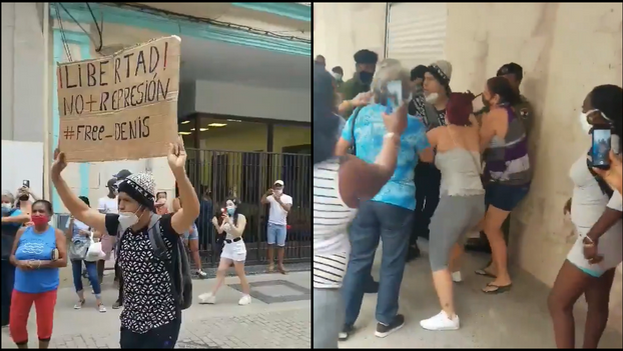
![]() 14ymedio, Yoani Sánchez, Havana, 22 February 2021 — What are the signs that predict the end of an authoritarian system? What symptoms does a despotic regime show as its decline approaches? These two questions have obsessed me in recent days, in the midst of unprecedented events that have been happening on this Island for weeks. Are they the clear death rattles of a dictatorship or just the rearrangement of a political model that refuses to die?
14ymedio, Yoani Sánchez, Havana, 22 February 2021 — What are the signs that predict the end of an authoritarian system? What symptoms does a despotic regime show as its decline approaches? These two questions have obsessed me in recent days, in the midst of unprecedented events that have been happening on this Island for weeks. Are they the clear death rattles of a dictatorship or just the rearrangement of a political model that refuses to die?
Protests in front of ministries, officials fighting back with an improvised and defensive discourse, massive solidarity against those stigmatized by official propaganda and an increase in social criticism, which no longer targets only the branches but goes against pillars of the system such as its leaders, its management of history and its management of national resources. Are these the agonies? Has the end already begun?
In other times, the audacity of those who now complain on social networks or outside an institution would have been answered more forcefully. The video clip Patria y vida, which has caused so much bitterness in Cuban officialdom, would have unleashed a fury of concerts in squares and parks throughout the country, to which the Government would bring its most faithful artists, in an endless and expensive show of “revolutionary reaffirmation.”
At the beginning of this century, the so-called Battle of Ideas was just that, a strategy to harness, through the channel of obedience, a society that had been ideologically “slackening” during the hard years of the Special Period. Those constant massive acts and the creation of social workers, red guards who responded directly to power, were some of the strategies used to tighten the political screw.
In the past, for every young person who stood in front of the Ministry of Culture this January, the Plaza of the Revolution would have mobilized another hundred – shouting slogans and waving banners – to “crush” with numbers the daring ones who demand greater creative freedoms and the end of censorship. The morning assemblies in schools with visceral attacks on these “enemies” and the meetings of militants to start commitments to support the system would have multiplied to the point of paroxysm.
But those times are no longer. The pandemic has tied the hands of the authorities who know that any call to meet physically not only presents a danger of contagion, but will be highly frowned upon and criticized by the population, as happened with the Government-sponsored “Tángana [brawl] en el Trillo [Park]. Young people for socialist democracy,” which was an attempt to respond to the events of November 27. The event only generated more outrage at the irresponsibility of bringing together hundreds of young people despite the dangers of covid-19.
A system that needs the constant mobilization and permanent recruitment of individuals so that they feel that they are soldiers who respond to orders and not citizens who demand rights is weakened when it cannot summon, gather, and unite its troops in front of the leader.
The virus is not the only reason for the “lukewarm” official response that has been experienced in the streets. There is the lack of money. The ideological offensive at the beginning of this millennium was propped up with Venezuelan resources. That uproar was only possible because Hugo Chávez made the necessary oil available to Fidel Castro to finance his political excesses and delusions. Now, Venezuela is economically sunk and the Cuban state coffers contain only debts and cobwebs.
Without a single peso to squander on ideological displays, and on the ropes due to the rebound in the pandemic and burdened by the growing popular unrest, the regime has only been left with the use of national media and social networks to try to counteract so much rebellion. Hence the constant smear campaigns that air on primetime television and fill the newspapers. Where, before, we had the parade and the march, now there are only a few “hateful minutes” left on the screen.
But this is little, very little compared to what Cuban power would have done in other times. Is this inability to show ideological muscle, in reality, a sign of the end? Before dying, do dictatorships fade, losing the streets and squares?
____________
COLLABORATE WITH OUR WORK: The 14ymedio team is committed to practicing serious journalism that reflects Cuba’s reality in all its depth. Thank you for joining us on this long journey. We invite you to continue supporting us by becoming a member of 14ymedio now. Together we can continue transforming journalism in Cuba.
